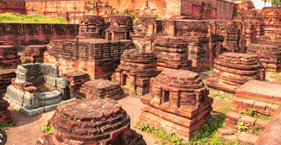

Context
Patna circle of the Archaeological Survey of India (ASI) has discovered two 1200-year-old miniature votive stupas during landscaping activities.
About
- Location:It has been found near Sarai Tila mound within the premises of 'Nalanda Mahavihara', a world heritage site in Nalanda district in the state.
- The stupas, carved from stone, depict Buddha figures.

What are stupas?
- A Stupa is a hemispherical structure which symbolizes the burial mound of Buddha. It rose to prominence after the advent of Buddhism and peaked during Ashoka’s reign. Stupas evolved as Chorten in Tibet and pagodas in East Asia.
|
Nalanda Mahavihara site:
|
Importance of stupas
- Religious importance –
- Relic repository: In the beginning stupas were built to venerate and safeguard relics and remains of Buddha.
- Sacred place: Along with monasteries (viharas) later, stupas were included in chaityas, which is a prayer hall.
- Circumambulation path: an important Buddhist ritual around the path surrounding it.
- The object of veneration– it is believed that relics of buddhas body were buried within the stupas
- Philosophical–
- Meditation:It is an important place for meditation.
- Commemorative: In the Tibetan tradition, stupas were built to celebrate the life events of the Buddha.
- Symbolic: The stupas encapsulate the teachings and ideology of Buddha
- g. Dhamek stupa at Sarnath marks the spotwhere the Buddha gave his first sermon after attaining enlightenment, revealing his Eightfold Path leading to nirvana.
- Historical: Provide information about the various dynasties who ruled India. Eg :
- Mauryas: Bairat stupa , Sanchi stupa , Bharhut stupa etc
- Sathavahanas: Amaravati stupa etc
- Architectural –
- Oldest stone structures: The stupas at Sanchi and Bharhut are one of the oldest stone structures in India.
- Inclusion of text in narrative panels– at Bharhut (Queen Maya’s dream)
- Use of marble– at Amravati stupa
- Taxila excavations reveal stupas with Boddhisatva images, Gandhara influence and patronage of Kanishka.

